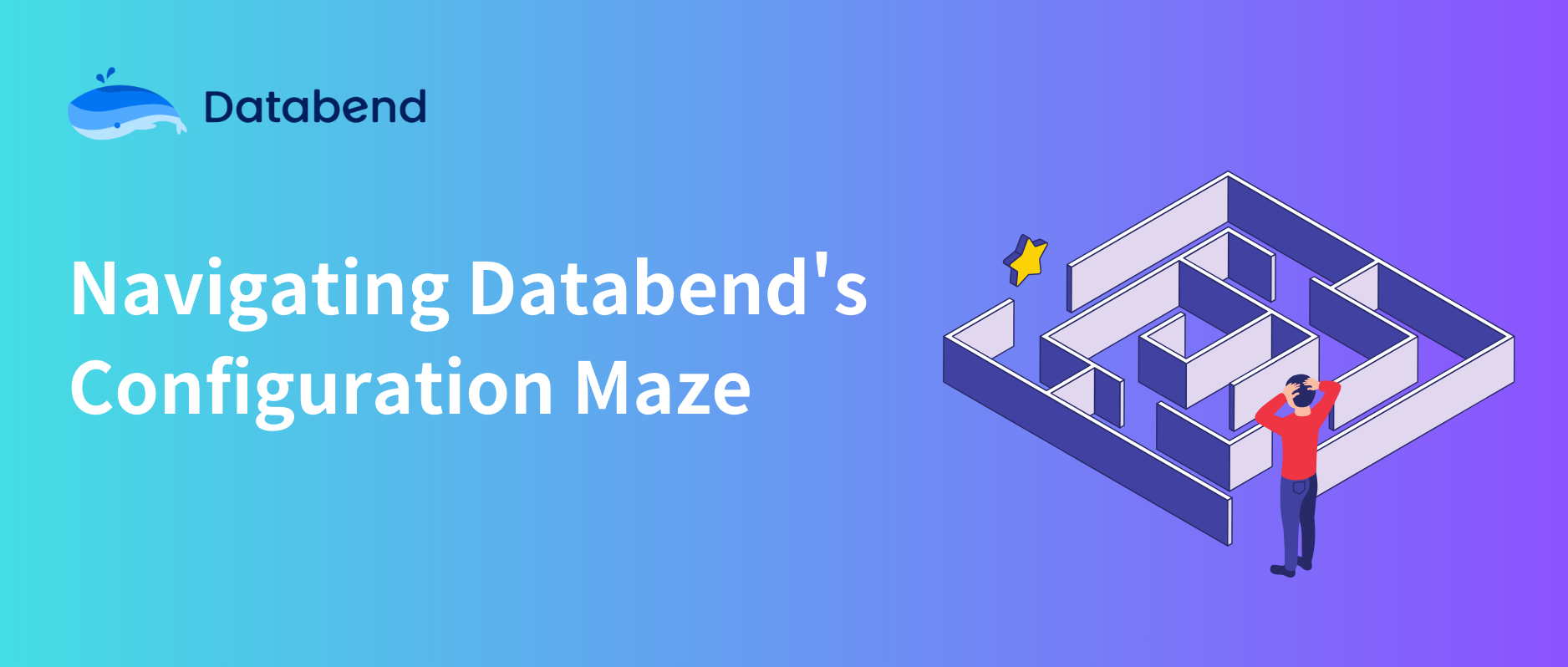Navigating Databend's Configuration Maze: A Guide for Developers and Operators
October 18, 2023 · 7 min read

PsiACE
This blog post explores the configuration management in Databend. It discusses the three supported configuration options: command-line arguments, environment variables, and configuration files, with their respective priorities. The post also delves into the mapping of configurations in Databend Query and Databend Meta, providing code examples and explanations.

Databend, a powerful data warehouse, offers a myriad of configuration options for its Query and Meta services. Understanding and managing these configurations can be overwhelming, especially when it comes to the various formats and syntaxes used in different environments. In this post, we'll demystify Databend's configuration landscape and provide a comprehensive guide to help developers and operators alike successfully navigate its complexities.
Configuration Basics
Before diving into the specifics of Query and Meta configurations, it's essential to understand the basics. Databend supports three configuration methods, each with its own priority and use case:
- Command-line options: Useful for temporary, local overrides of environment variables or configuration files.
- Environment variables: Ideal for Kubernetes and other cloud environments, allowing for flexible configuration changes without altering the configuration files.
- Configuration files: The recommended approach for most use cases, providing a structured and version-controlled way to manage configurations.
Configuration in Databend Query
Regardless of the configuration method used, the configuration options in Databend Query can be seen as a flattened tree-like mapping of code, following the logic of "configuration domain" + "configuration item."
- In environment variables and configuration files, the code is flattened using
serfig, with
_used as a separator. - Command-line options differ slightly: they use
-as a separator, and some command-line arguments do not have a bound configuration domain.
Example: admin_api_address Configuration
To better understand the mapping relationship, let's start with the
admin_api_address configuration option. This setting determines the address
and port that the admin API will listen on.
In a TOML configuration file, the setting is defined as follow. The
querysection represents the configuration domain, and theadmin_api_addressis the specific option within that domain.[query]
...
# Databend Query http address. For admin RESET API.
admin_api_address = "0.0.0.0:8080"
...In environment variable, it is represented as
QUERY_ADMIN_API_ADDRESS, whereQUERYrepresents the configuration domain andADMIN_API_ADDRESSis the specific configuration option. To set the admin API address using an environment variable, you can use the following command:export QUERY_ADMIN_API_ADDRESS=0.0.0.0:8080Command-line option, however, do not follow the same naming convention as environment variable or configuration file. Instead, the configuration option is used. So, you can adjust this value using the
--admin-api-addresscommand line argument. For example, to set the admin API address to0.0.0.0:8081, you can use the following command:databend-query --admin-api-address=0.0.0.0:8080
Note: In this case, command-line option is not bound to a specific configuration domain. However, if configuring
--storage-s3-access-key-id, the configuration domain would be "storage" + "s3", and "access-key-id" would be the specific configuration option. You can use "databend-query --help" to view all supported command-line arguments.
Mapping Configuration Options to Code
Let's dive into the code related to configuration to further understand the
mapping relationship (located in src/query/config/src/config.rs):
pub struct Config {
...
#[clap(flatten)]
pub query: QueryConfig,
...
}
/// Query config group.
#[derive(Clone, Debug, PartialEq, Eq, Serialize, Deserialize, Args)]
#[serde(default, deny_unknown_fields)]
pub struct QueryConfig {
...
#[clap(long, default_value = "127.0.0.1:8080")]
pub admin_api_address: String,
...
}
In the code, the top-level structure is Config, and admin_api_address is a
configuration option within pub query: QueryConfig. After processing with
serfig, it needs to be represented by either "QUERY" or "[query]" to indicate
its configuration domain, while the configuration option remains as
admin_api_address.
For command-line options, the specific option name and default value are
controlled by #[clap(long = "<long-name>", default_value = "<value>")].
clap takes over the configuration:
admin_api_addressbecomes--admin-api-address.- For
--storage-s3-access-key-id, the actual code hierarchy isConfig -> StorageConfig -> S3StorageConfig -> access_key_id, annotated with#[clap(long = "storage-s3-access-key-id", default_value_t)]. Therefore, it needs to be configured with--storage-s3-access-key-id.
Configuration in Databend Meta
The Meta service's configuration follows a similar structure to the Query
service, with command-line arguments and configuration files playing a similar
form. However, environment variables are managed using custom one-to-one
mappings (powered by serde-env in serfig), but can still be understood based
on "configuration domain" + "configuration option".
Example: log_dir Configuration
Let's explore the mapping between the different configuration methods for the
log_dir option:
In the configuration file, it applies globally and can be set as:
log_dir = "./.databend/logs"In environment variables, it needs to be set as
METASRV_LOG_DIR, whereMETASRVrepresents the configuration domain, and "LOG_DIR" is the specific configuration option.expert METASRV_LOG_DIR=./.databend/logsFor command-line configuration, it can be set directly using
--log-dir.databend-meta --log-dir=./.databend/logs
Mapping Configuration Options to Code
Now, let's deconstruct the mapping through the code (located in
src/meta/service/src/configs/outer_v0.rs):
#[derive(Clone, Debug, Serialize, Deserialize, PartialEq, Eq, Parser)]
#[clap(about, version = &**METASRV_COMMIT_VERSION, author)]
#[serde(default)]
pub struct Config {
...
/// Log file dir
#[clap(long = "log-dir", default_value = "./.databend/logs")]
pub log_dir: String,
...
}
The configuration options related to configuration files and command-line
options are managed by the Config structure, following the same logic as
Databend Query.
For environment variables, the configuration options are processed by the
ConfigViaEnv structure, which is generated by the macro serde::Deserialize,
based on the Config structure.
/// #[serde(flatten)] doesn't work correctly for env.
/// We should work around it by flatten them manually.
/// We are seeking for better solutions.
#[derive(Clone, Debug, Serialize, Deserialize, PartialEq, Eq)]
#[serde(default)]
pub struct ConfigViaEnv {
...
pub metasrv_log_dir: String,
...
}
// Implement Into target on ConfigViaEnv to make the transform logic more clear.
#[allow(clippy::from_over_into)]
impl Into<Config> for ConfigViaEnv {
fn into(self) -> Config {
...
Config {
// cmd, key, value and prefix should only be passed in from CLI
...
log_dir: self.metasrv_log_dir,
...
}
}
}
Therefore, metasrv_log_dir corresponds to the environment variable
METASRV_LOG_DIR, and ultimately maps to the log_dir option in Config, thus
associating it with the configuration file and command line option --log-dir.
Implicit Environment Variables
While some environment variables is not a formal option listed in the configuration options, it can still be used as an environment variable for configuration purposes.
This is mainly due to the absence of setting corresponding configuration options, which triggers the rollback mechanism of reqsign. It reads some commonly used environment variables of the corresponding service to ensure its proper operation as much as possible.
The mapping and usage of these environment variables can be understood by examining the relevant code sections.
Example: AWS_ACCESS_KEY_ID Environment Variable
In the implementation, there is a check for the STORAGE_S3_ACCESS_KEY_ID
configuration option, which aligns with the configuration and environment
variable mapping.
However, if the corresponding configuration is not provided, a fallback
mechanism is triggered. reqsign will check AWS_S3_ACCESS_KEY_ID to obtain
possible value.
This is also the reason why commands like the one below can work correctly.
docker run \
-p 8000:8000 \
-p 3307:3307 \
-v meta_storage_dir:/var/lib/databend/meta \
-v query_storage_dir:/var/lib/databend/query \
-v log_dir:/var/log/databend \
-e QUERY_DEFAULT_USER=databend \
-e QUERY_DEFAULT_PASSWORD=databend \
-e QUERY_STORAGE_TYPE=s3 \
-e AWS_S3_ENDPOINT=http://172.17.0.2:9000 \
-e AWS_S3_BUCKET=databend \
-e AWS_ACCESS_KEY_ID=ROOTUSER \
-e AWS_SECRET_ACCESS_KEY=CHANGEME123 \
datafuselabs/databend
Mapping Implicit Environment Variables to Code
Let's examine the relevant code snippet in src/common/storage/src/operator.rs
(line 244):
builder.access_key_id(&cfg.access_key_id);
The access_key_id() function in the default behavior of the opendal library
handles the configuration:
/// Set access_key_id of this backend.
///
/// - If access_key_id is set, we will take user's input first.
/// - If not, we will try to load it from environment.
pub fn access_key_id(&mut self, v: &str) -> &mut Self {...}
Since disable_config_load is not explicitly set, the S3 accessor will attempt
to load the configuration from the environment variables while building. The
code snippet responsible for this behavior is found in AwsConfig in the
reqsign library:
pub struct AwsConfig {
/// `access_key_id` will be loaded from:
/// - this field if it's `is_some`
/// - env value: `AWS_ACCESS_KEY_ID`
/// - profile config: `aws_access_key_id`
pub access_key_id: Option<String>,
...
}
So if access_key_id is not provided, the library will attempt to load it from
the AWS_ACCESS_KEY_ID environment variable.
This also allows you to choose familiar AWS or other service examples' default environment variables when using Databend in practice.
Conclusion
Understanding configuration management in Databend is crucial for developers and operators to effectively manage and fine-tune the database server program. By leveraging command-line arguments, environment variables, and configuration files, users can tailor the configurations to meet their specific needs. The code examples and explanations provided in this blog post serve as a guide to navigating the configuration management in Databend Query and Databend Meta.
🎈Connect With Us
Databend is a cutting-edge, open-source cloud-native warehouse built with Rust, designed to handle massive-scale analytics.
Join the Databend Community to try, get help, and contribute!